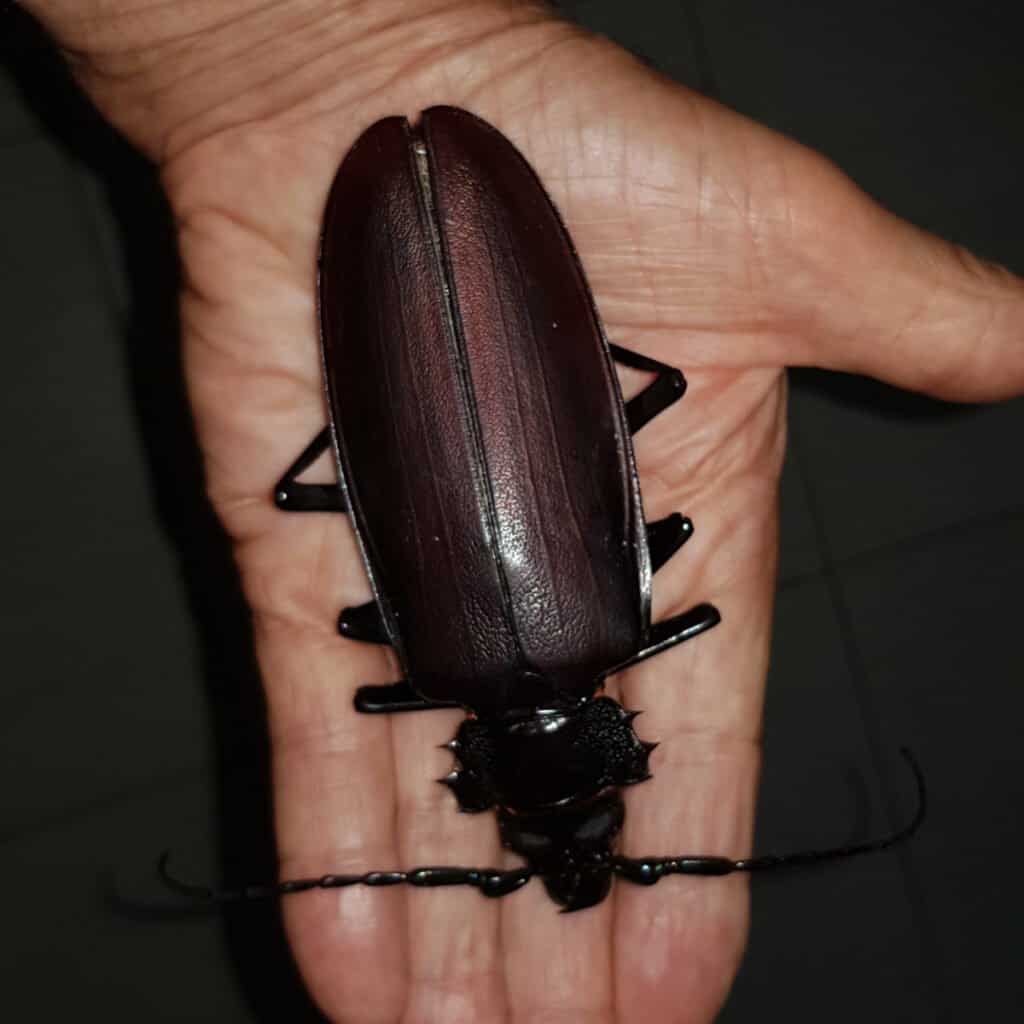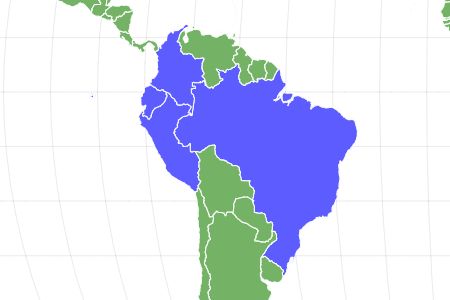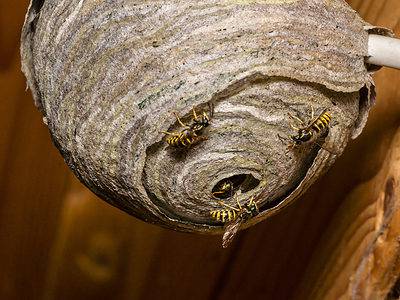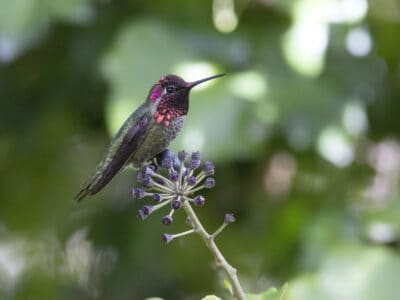Titan Beetle
Titanus giganteus
Their jaws can bite through a wooden pencil.
Advertisement
Titan Beetle Scientific Classification
- Kingdom
- Animalia
- Phylum
- Arthropoda
- Class
- Insecta
- Order
- Coleoptera
- Family
- Cerambycidae
- Genus
- Titanus
- Scientific Name
- Titanus giganteus
Read our Complete Guide to Classification of Animals.
Titan Beetle Conservation Status
Titan Beetle Facts
- Name Of Young
- Larvae
- Group Behavior
- Solitary
- Fun Fact
- Their jaws can bite through a wooden pencil.
- Biggest Threat
- Loss of habitat
- Most Distinctive Feature
- They can grow up to 6.5 inches long, the largest beetle in the world.
- Habitat
- Tropical rainforest
- Diet
- Herbivore
- Lifestyle
- Nocturnal
- Favorite Food
- Decaying wood pulp
- Special Features
- They can get up to 6.5 inches long.
- Number Of Species
- 1
- Location
- South America
- Nesting Location
- Decaying logs
Titan Beetle Physical Characteristics
- Color
- Brown
- Skin Type
- Shell
- Length
- Up to 6.5 inches
- Venomous
- No
- Aggression
- Low
View all of the Titan Beetle images!
Have you ever held a beetle that was as large as your hand? Time to meet the Titan Beetle!
At over 6 inches long, the Titan Beetle is the largest beetle in the world, and one of the largest insects that we know of. They have strong mandibles and sharp spines to help them defend themselves. While they are large and imposing, these beetles are not aggressive and only act in defense when threatened.
Titan Beetle Facts
- There is only one species of Titan Beetle within the genus, the Titanus giganteus.
- Titan Beetles are popular with insect collectors. Because female Titan Beetles are hard to find, almost all collected specimens are male.
- Even though they are very large, adult Titan Beetles do not eat anything. They can fly but only do so for short bursts to conserve energy.
- Scientists do not know how long Titan Beetles live because they have not found actual Titan Beetle larvae to study. Instead, they study the evidence that the larvae leave behind.
- These giant beetles live in the tropical rainforests of South America. Deforestation and loss of habitat impact these beetles, although they are not yet listed on the endangered species list.
Titan Beetle Species, Type, and Scientific Name
The Titan Beetle is known by its scientific name Titanus giganteus. It also happens to be the only species within its genus, Titanus. Due to its unusual size, there aren’t any other beetles that compare and can be classified together with this monstrous insect.
It belongs to the Prioninae subfamily within the Cerambycidae family. These beetles are called long-horned beetles because most have long antennas that resemble horns. The Titan Beetle is a great example of this. While there are species within the Cerambycidae family that have longer antennas relative to their overall size, the Titan Beetle’s antennas are still some of the longest.
They are part of the Coleoptera order. This includes all beetles, over 400,000 species total. Beetles have hard front wings called elytra. Some are very small, while others such as the Titan Beetle are large. They belong to the Insecta class, Arthropoda phylum, and Animalia kingdom.
Appearance: How to Identify Titan Beetles
As their name suggests, Titan Beetles are very, very large. In fact, this is their most easily recognizable characteristic. It’s hard to miss a Titan Beetle! They can grow up to 6.5 inches long. Notable photographs show people holding Titan Beetles. The insects are larger than the person’s hand in some cases.
They have curved mandibles at the front of their head, used to snap and bite. These mandibles are sharp and strong enough to bite people when they feel threatened. They aren’t naturally aggressive but do possess plenty of defensive mechanisms, including their bite, that they can use if they are threatened.
Titan Beetles are dark brown and have the characteristic hard-shell elytra of all beetles. Because they are so large, these features are easy to see and study. Their antennas curve backward and reach about halfway back on their overall body length. Like all other bugs, they have six legs.
They also have sharp spines that they use as a defense against predators. This can also make handling a Titan Beetle a bit challenging. Their mandibles have enough force to snap a pencil in two or bite your hand or finger. Make sure that if you ever do hold a Titan Beetle, you do so with plenty of care.

This photo gives a true indication of the size of the Titan Beetle.
©guentermanaus/Shutterstock.com
Habitat: Where to Find Titan Beetles
These giant beetles call South America home. They live in tropical rainforests where they hatch, grow through the larvae stage, pupate, and become adults. They spend most of their lives as larvae, although scientists have yet to find a larvae specimen so they aren’t sure exactly how long that period is. Instead, they have found evidence of larvae that they link to Titan Beetles. When they do pupate and become adults, scientists think that they only live a few weeks, just long enough to mate and reproduce.
Titan Beetles are found in Brazil, Colombia, Peru, and Ecuador. They are the largest beetle in the Amazon rainforest that we know about and one of the largest insects overall in the world.
Diet: What Do Titan Beetles Eat?
They live in the tropical rainforest. Scientists believe that the larvae forms eat decaying wood, based on evidence of holes bored through logs that they think belonged to Titan Beetle larvae. These logs are below the ground, showing that these larvae may dig or bore down to get their food.
Amazingly, Titan Beetle adults do not eat anything. Even though they are large and capable of flight and movement, they do not seem to need any nourishment in this phase of their lives. Some insects eat everything that they need as larvae and then spend the short period of their adult lives focused on reproducing. Researchers believe that Titan Beetles do the same.
Prevention: How to Get Rid of Titan Beetles
Titan Beetles do not pose a threat so it is not necessary to prevent or get rid of them. If you are worried about their bite, just give the Titan Beetle its space. They are not aggressive and will only bite when they feel that they are being threatened. This is most common when they are looking for mates. Fortunately, Titan Beetles hiss to warn you that you are getting too close or that they are starting to get worried. This is meant as a warning and not aggression.
Adult Titan Beetles are nocturnal. Some people try to attract Titan Beetles using lights. The males are attracted to light when they fly around at night. Collectors prize these beetles due to their size and status as the largest beetle in the world. Female Titan Beetles are hard to find because they do not fly around looking for mates. Most Titan Beetle specimens are male. Fortunately, this does not impact the population of Titan Beetles because the females are left to lay their eggs.
Because Titan Beetles are very large, they cannot squeeze into tight spaces such as the crevices in your home like other beetle species. For the most part, they tend to live their short adult lives away from people. The larvae feed on decaying wood below the ground and are not seen.
Loss of habitat is the most significant threat to the Titan Beetle. While they are not listed as endangered, the destruction of the tropical rainforests has a direct impact on Titan Beetles. Without trees in the rainforest, the larvae do not have a food source. Efforts to protect the rainforest are beneficial to Titan Beetles.
Similar Insects to Titan Beetles
Goliath Beetle: There are five species within the Goliathus genus known as Goliath Beetles. They can grow up to 4.3 inches long. Goliath Beetles are sometimes raised as pets, eating cat or dog food to get their protein.
Hercules Beetle: This rhinoceros beetle also lives in the tropical rainforest and is recognized as the longest beetle in the world. However, the majority of its length is in its horn. It is very strong, which gives it the name Hercules Beetle.
View all 133 animals that start with TTitan Beetle FAQs (Frequently Asked Questions)
What makes Titan Beetles different from other beetles?
Not only are they the largest beetle in the world, Titan Beetles also have extremely strong mandibles. They can bite through a pencil and pierce skin.
Are Titan Beetles harmful?
No, Titan Beetles are not dangerous or aggressive. They will hiss if they feel threatened and can be difficult to handle due to their sharp jaws and spines. If they feel threatened, they may attack using these defense mechanisms.
How big do Titan Beetles get?
The largest known specimen of an adult Titan Beetle was 6.5 inches long. The Smithsonian Institute has a specimen that is 5.5 inches long.
Thank you for reading! Have some feedback for us? Contact the AZ Animals editorial team.
Sources
- Smithsonian, Available here: https://www.si.edu/newsdesk/snapshot/titan-beetle
- Kids Discover, Available here: https://kidsdiscover.com/quick-reads/34551/#:~:text=Are%20they%20dangerous%3F,t%20mess%20with%20the%20titan!
- All Things Pest Removal, Available here: https://allthingspestremoval.com/titan-beetle/

















